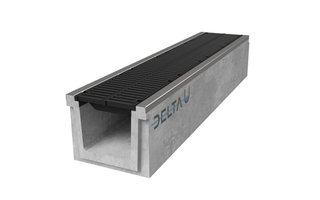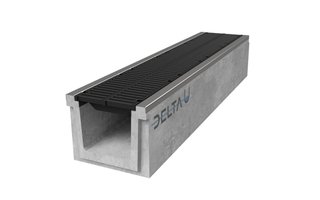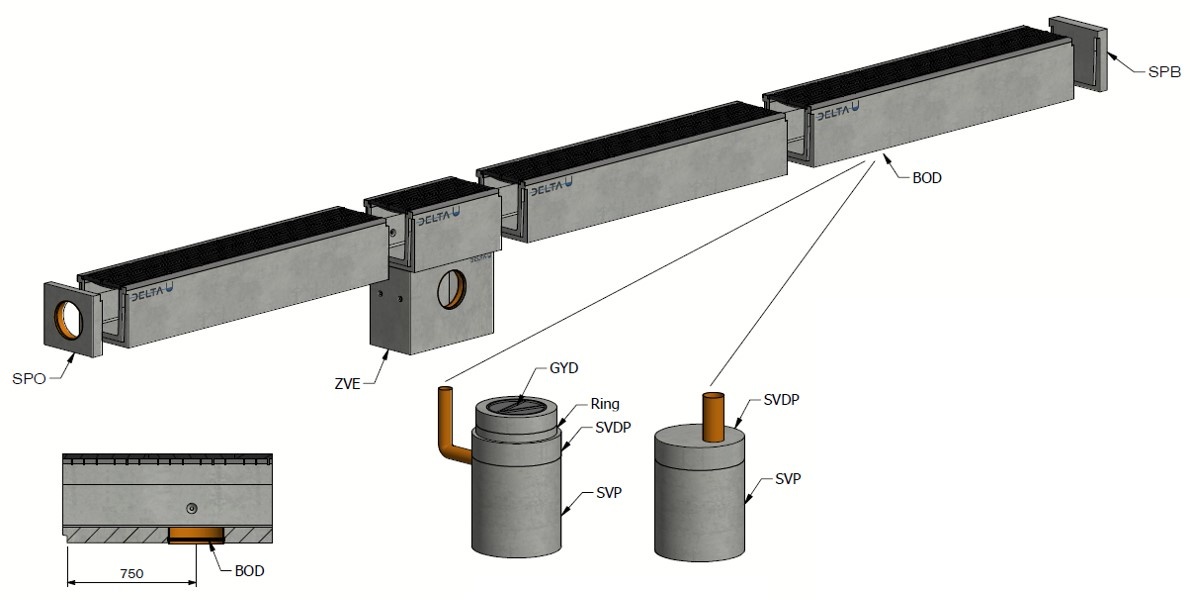You have no items in your shopping cart
Self-supporting grid gutters Delta U, F900KN
Grate gutters are usually installed in places where water drainage is required, such as driveways, patios, sidewalks and parking lots. The grate on the gutter prevents dirt, leaves and other contaminants from clogging the drainage system. They can also have different sizes depending on the specific needs and the amount of water to be drained. Gutters are an effective solution for preventing flooding and maintaining infrastructure.
Why install grid gutters?
There are several reasons why installing grid gutters is a wise choice. First of all, grid gutters help prevent flooding. By draining rainwater quickly and efficiently, it prevents it from accumulating in certain areas, such as driveways or patios, which can lead to puddles and muddy situations. In addition, grid gutters contribute to the protection of the foundation. The rainwater is drained directly to the sewer or another suitable place, which reduces the chance of soil saturation and possible damage to the foundation. In addition, grid gutters also improve the aesthetic appearance of a site. By choosing grid gutters with an attractive design and matching color, they can be seamlessly integrated into the environment and form a visually attractive element. In short, installing grid gutters offers many advantages, including preventing flooding, draining rainwater, protecting the foundation and improving the aesthetic appearance.
Grate gutter or gully?
A grate gutter and a gully are both drainage systems that are used to drain rainwater and other surface water. The difference between a grid gutter and a gully mainly lies in the way in which they collect the water. A grid gutter (line drainage) is a concrete gutter with a grid on top, through which the water can flow. The grid prevents leaves, branches and other debris from entering the gutter and causing blockages. A gully (point drainage), on the other hand, is a well or drain in which the water is collected. There is an odor trap in the gully that prevents dirt from entering the drain pipe. The function of a grid gutter is to collect and drain rainwater that flows down from the street surface. The gutter ensures that the water is drained in a controlled manner, preventing flooding and flooding. Grate gutters are often used along roads, parking lots and other paved surfaces. The function of a gully is comparable to that of a grid gutter: collecting and draining rainwater. The difference is that a chamber collects the water underground and drains it through a drainage pipe. Grate ducts have different applications depending on the environment in which they are used. They can be used along roads and parking lots to drain rainwater. In addition, grid gutters are often used in areas with many trees, such as parks and forests, to ensure that leaves and branches do not end up in the gutter. Gullies also have various uses. They are often used in urban areas where space is limited and there is no option for a grate gutter. Gullies are also used in squares, sidewalks and cycle paths to collect and drain rainwater. The maintenance and cleaning of grate gutters and gullies is important to prevent blockages. Grate gutters should be cleaned regularly to remove dirt, leaves and other contaminants. This can be done manually or using special cleaning equipment. Gullies should also be cleaned regularly to prevent debris from building up and clogging drain pipes.
Processing the gutter
Processing a gutter starts with the preparation of the surface. It is important to ensure that the surface is flat and firm so that the gutter can be installed properly. The gutter is then placed in the right place. In the case of grid gutters, you can opt for a concrete grid gutter. This concrete gutter offers a sturdy and durable solution for draining water. After installing the gutter, it is important to connect it to the sewer system. This ensures that the water is drained correctly. Finally, the gutter is finished so that it fits seamlessly with the environment. Any imperfections are smoothed out and the gutter gets a neat finish. To ensure that the gutter functions properly, a water drainage test is carried out. This checks whether the water is drained correctly through the gutter.
Would you like to receive more information?
Would you like to receive more information about grid gutters? There are various applications for grid gutters, such as draining rainwater on driveways, parking lots and in the garden. In addition, it is important to know how the installation and maintenance of grid gutters work, so that you can take this into account. It is also useful to know what dimensions and capacity grating gutters have, so that you can make the right choice for your specific situation. In addition, it is of course important to know what the price information is and which accessories are available for grid gutters. Finally, it is good to know what types of materials and finishes are available, such as concrete grid gutters. With these keywords you can search specifically for more information about grate gutters.
Function of grate gutters
Grate gutters have different functions. Firstly, they ensure the drainage of rainwater, which prevents flooding. This is especially important during heavy rainfall, where large amounts of water must be drained quickly to prevent flooding. In addition, grate gutters serve as a collection system for leaves and other dirt, preventing blockages and not impeding the drainage of water. This is especially important in areas with many trees and plants. Another important function of grid gutters is to protect the underlying structure. Installing a concrete grid gutter prevents rainwater from coming into direct contact with, for example, the foundation of a building, which can cause damage. Finally, grid gutters improve safety by preventing slippery surfaces. By draining the water quickly and efficiently, walking surfaces remain dry and the risk of slipping is reduced. All in all, grid gutters are essential for proper drainage of rainwater and contribute to maintaining the quality and safety of the environment.
Advantages and applications of grate gutters
Due to their design, grid channels can drain large amounts of water, preventing streets and roads from flooding during heavy rainfall. This contributes to the safety of pedestrians and cyclists, as they do not have to wade through puddles or drive on wet roads. In addition, grate gutters are made of concrete, which ensures durability and freedom from maintenance. Concrete grate gutters have a long lifespan and require minimal maintenance, making them cost-efficient. In addition, they are resistant to extreme weather conditions and wear and tear, making them ideal for use in high traffic areas. In short, grate gutters offer advantages in terms of water drainage, safety and sustainability.









